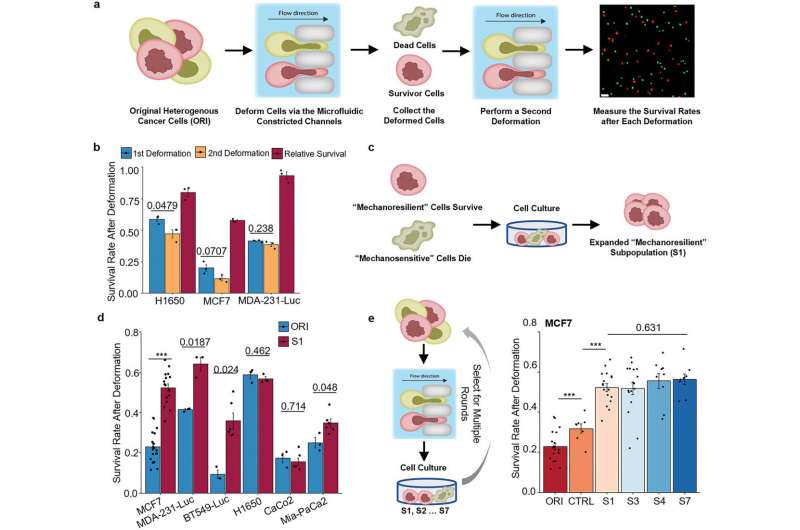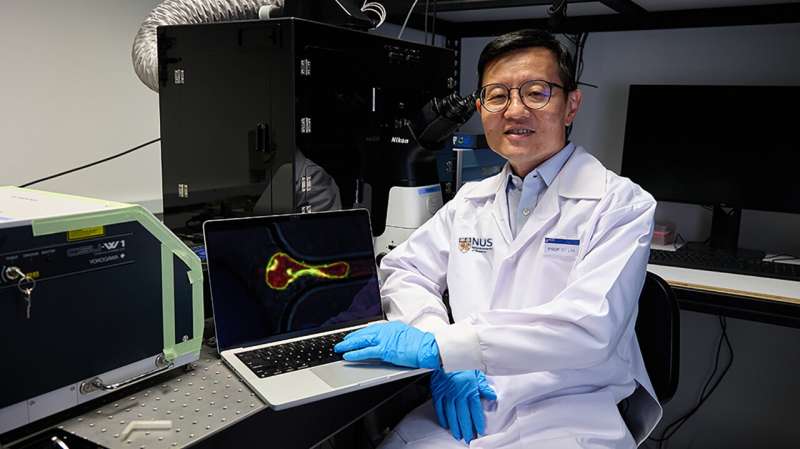This article has been reviewed according to Science X's editorial process and policies. Editors have highlighted the following attributes while ensuring the content's credibility:
fact-checked
peer-reviewed publication
trusted source
proofread
Study sheds a new light on cancer metastasis

The ability of cancer cells to metastasize, or spread from one part of the body to another, is one of the reasons why cancer can be extremely challenging to treat. However, the process that drives metastasis is complex and not fully understood.
In a recent study, scientists from the National University of Singapore (NUS) reveal the complex interactions between tumor cells and the microenvironment, and showed that some cancer cells are resilient to mechanical stress and such cells also have a stronger ability to multiply rapidly to form secondary tumors.
"Understanding how some cancer cells can survive mechanically induced cell death is key to preventing the spread of malignant tumors, and paves the way for more targeted therapies," explained lead author of the research Professor Lim Chwee Teck, who is Director of the NUS Institute for Health Innovation and Technology and holds an appointment at the Department of Biomedical Engineering under the NUS College of Design and Engineering.
Prof. Lim and his team reported these groundbreaking findings, a culmination of four years of research work, in the journal Advanced Science on 23 May 2023.

The body's innate immunity against cancer
Our body possesses a unique defense mechanism—known as immune surveillance—that targets circulating cancer cells in the bloodstream. This mechanism plays a crucial role in detecting and eliminating cancer cells.
The physical microenvironment in the form of tiny blood vessels, called capillaries, with diameters much smaller than that of circulating cancer cells, also plays a role in filtering out these cancer cells. Such narrow capillaries create physical barriers that restrict the passage of larger cancer cells. Cancer cells that cannot deform or squeeze through these tight spaces may become trapped or damaged, preventing their further dissemination.
Identifying cancer cells that are resilient to mechanical stress
How do certain circulating cancer cells avoid being ruptured by the shear forces within the body's dense system of small capillaries? To investigate this, the scientists designed a new experimental method to "force" different cancer cell lines through a series of small, capillary-sized constrictions. The majority of the cancer cells were ruptured and killed in the process. But the researchers also observed that a small population of each cancer cell line emerged relatively unscathed.
They further analyzed these surviving cancer cells and discovered that they carried a distinct molecular signature compared with the original set of cancer cells. Intriguingly, the scientists discovered that the ability of these cells to survive and proliferate was linked to specific properties of their nuclear membrane proteins, nuclear stiffness, and their self-repair capabilities.
Cancer cells that survived mechanical stress are more metastatic
The scientists characterized the surviving cancer cells as "mechanoresilient." They found out that in these cells, the DNA damage repair machinery, which is critical for cellular survival, was enhanced and more active than usual. These cells also exhibited greater malignancy—they could multiply more rapidly compared to the original cells and were also less susceptible to chemotherapy drugs.
Through a meta-analysis of different cancer types using data from cancer genome database, the scientists showed that the altered gene expression profiles in these cancer cells were linked to poorer disease prognosis and patient outcomes.
The research team also uncovered an unexpected link between the cancer cells' exposure to mechanical stress, and the onset of metastatic development. Although previous studies have shown that metastasizing cancer cells are more invasive and resistant to cancer therapies compared to localized cancer cells in primary tumors, it was not previously clear if mechanical stress played a direct role in this transformation.
In this study, NUS scientists put the cancer cells through multiple rounds of mechanical stress and concluded, for the first time, that mechanical stress could potentially contribute to the surviving cancer cells gaining proliferation ability and drug resistance.
Paving the way for more targeted cancer therapies
Understanding the molecular traits of mechanoresilient cancer cells thus open up a new avenue for cancer treatment. Therapeutic approaches could potentially be developed to target specific nuclear membrane proteins and inhibiting the self-repair ability of the cancer cells to achieve positive treatment outcomes.
Additionally, identifying the biomarkers associated with mechanoresilience in cancer cells can be used to diagnose or even predict patient response to therapy.
Further research may also contribute towards the development of a novel diagnostic method for cancer. For example, a detailed imaging of the cancer cell nucleus could reveal the presence of mechanoresilient cells, to help doctors in selecting a suitable treatment option that prevents the onset of metastasis.
More information: Kuan Jiang et al, Deleterious Mechanical Deformation Selects Mechanoresilient Cancer Cells with Enhanced Proliferation and Chemoresistance, Advanced Science (2023). DOI: 10.1002/advs.202201663




















